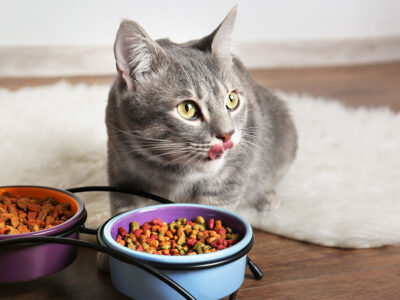Choosing the right food for your pet can be a big decision, and one that weighs heavy on the minds of many pet owners.
There are so many options out there—dry, canned, freeze-dried, raw, “all-natural,” grain-free, etc.—and even more information and opinions to support or refute these various options.
And then you need to decipher the list of cat food or dog food ingredients in each potential formula to know what you are actually feeding your pet.
So where does one start? How do you make an informed decision about which diet is best for your dog or cat?
This guide will break down pet food labels and some common ingredients in dog food and cat food so that you can find the best food for your pet.
Nutritional Needs and Requirements
The single-most important consideration in selecting a pet food is ensuring that the diet meets your pet’s nutritional needs of more than 30 essential nutrients, including:
Protein
Amino acids
Fatty acids
Vitamins
MineralsThe right pet food should provide all nutrients in sufficient quantity and with appropriate ratios for your pet’s given life stage. That means that your pet’s food should provide enough calories to maintain their body weight at their particular life stage (e.g., adult maintenance, puppy/growth, geriatric, etc.).
AAFCO Approval and Label Requirements
A diet that meets these basic nutritional needs is referred to as “complete and balanced,” which should be indicated on the label as the Nutritional Adequacy Statement by the Association of American of Feed Control Officials (AAFCO).1
Additional label information required by the Food and Drug Administration (FDA) includes the following:
Product identification (what it is)
Net quantity
Manufacturer or distributor name and address
Ingredient listAAFCO recommends also including:
Feeding directions
Guaranteed analysis
Caloric contentUnderstanding Pet Food Package Terms
Pet foods are often labeled with eye-catching phrases, like “all-natural,” “organic,” or “wholesome.”
These terms sound similar but can mean quite different things about the product. Some of these terms are regulated by AAFCO and the FDA, while others are not. It’s important to know the difference and what these words actually mean.
Here is an abbreviated version of the AAFCO definition that can help guide you, but if you want more information, visit AAFCO Talks Pet Food.
Regulated Terms: USDA, FDA, and/or AAFCO USDA Organic Seal
Organic
This term is regulated and is signified with a USDA Organic Seal.
The United States Department of Agriculture (USDA) Organic seal means that the pet food production and handling adhere to the requirements established by the USDA’s National Organic Program for human food regulation.
Certified organic pet foods must be made of at least 95% organic ingredients, and the use of synthetic fertilizers, sewage sludge, irradiation, and genetic engineering is not permitted.1
Human-Grade
There is no true definition for this in animal feed regulations, but according to AAFCO, for a pet food to be considered “human-grade,” every ingredient must be “human edible” and “manufactured, packaged, and held in accordance with federal regulations.”
Very few pet foods can meet this standard, so if you see “human-grade” on the label, you might want to call the company to ask about their manufacturing procedures .1
Terms That Are Not Regulated
Natural, All-Natural, or 100% Natural
The label claim of “natural” has a loose definition.
Natural dog or cat food ingredients must be of plant, animal, or mined sources, which most ingredients are, and can undergo any manufacturing process except a chemically synthetic process.
Chemically synthesized ingredients include many vitamins and minerals, preservatives, and flavor and/or color additives.
“All-natural” or “100% natural” means that every ingredient used complies with this, or the label can specify certain ingredients as “natural” (e.g., “natural chicken flavor”).
If a product is “all-natural” or “100% natural,” it is not likely to be complete and balanced, because most vitamins and minerals that are added to pet foods are synthetic. Therefore, supplementation would likely be necessary to meet your pet’s specific nutrient requirements.1
Holistic or Wholesome
The terms “holistic” and “wholesome” are used to imply “whole-body health,” but they do not tell you anything about what ingredients are included, how or where the ingredients were sourced, or how the product was manufactured or handled.
Raw
Most manufactured retail pet foods are not truly raw, as heat processes are often used to prevent bacterial growth.
If a food is labeled as raw and is not misbranded, it’s important to follow sanitary handling practices for raw meat to minimize bacterial cross-contamination.
Understanding the Ingredient Label
Of the regulated information on a pet food label, most pet owners perceive the ingredient list to be the most important.
The FDA requires that every ingredient included is named following the established AAFCO definitions and that ingredients are listed in descending order of predominance by weight. This means that the heaviest ingredients are listed first.
Quality and Quantity of Cat and Dog Food Ingredients
The list does not provide any information on the quality of the cat or dog food ingredients included or whether they are used in amounts that provide any sort of nutritional benefit to your pet.
For example, ingredients that appeal to pet owners, like blueberries and kale, probably provide little nutritional benefit to your pet because of the relatively small quantities added, whereas poultry by-product sounds less appealing but is included as a primary ingredient because it provides your pet with essential nutrients.
Contacting the Pet Food Manufacturer
If you ever have a question about the ingredients in cat food or dog food, do not hesitate to do a little homework.
Some pet food manufacturers have very descriptive websites with lists of commonly used ingredients and descriptions, but if you cannot find the information there, contact the manufacturer.
A responsible pet food manufacturer should provide you with the ingredient information, including the source and why it is included in their formulation.
Glossary of Cat and Dog Food Ingredients
The list of ingredients in cat food and dog food can be exceptionally long with confusing terminology.
However, it’s important to understand the established definitions for those terms so that you can make a well-educated decision on which food to feed your pet, rather than a decision led by perception.
Here’s a breakdown of some of the most common cat food and dog food ingredients and what they mean.
Jump to a specific term here:
Amino Acids
Arginine | Histidine | Isoleucine | Leucine | Lysine | Methionine | Phenylalanine | Taurine | Threonine | Tryptophan | Valine | L-carnitine | L-lysine monohydrochloride | L-cysteine | DL-methionine
Animal Products
Animal By-Product Meal | Animal Digest | Dried Egg Product | Meat | Meat and Bone Meal | Meat By-Products | Meat Meal | Poultry | Poultry By-Products | Poultry By-Product Meal | Poultry Meal
Fats/Oils
Animal Fats | Coconut Oil | Fish Oils | Glycerin | Palm Kernel Oil | Vegetable Oils
Gums
Carrageenan | Cassia Gum | Guar Gum | Xanthan Gum
Hydrolyzed Protein
Plant Products
Cellulose
Grains | Bran | Gluten | Hull | Meal and Flour | Middlings (“Midds”) | Starch
Corn | Whole Corn, Ground Corn, Cornmeal, and Corn Flour | Corn Starch | Corn Gluten
Legumes (Beans, Lentils, Peas, Soybean) | Peas | Pea Fiber | Pea Protein | Pea Starch | Soybean Flour
Root Vegetables | Beet Pulp | Cassava Root Flour | Potato Protein | Potato Starch | Potatoes
Minerals
Boron | Calcium | Chloride | Chromium | Cobalt | Copper | Fluorine | Iodine | Iron | Magnesium | Manganese | Molybdenum | Phosphorous | Potassium | Salt/Sodium Chloride | Selenium | Sodium | Sulfur | Zinc
Natural Flavors
Preservatives
Artificial Preservatives | Butylated Hydroxyanisole (BHA) | Butylated Hydroxytoluene (BHT) | Ethoxyquin |
Natural Preservatives | Ascorbic Acid (Vitamin C) | Calcium Propionate | Mixed Tocopherols
Probiotics
Bifidobacteria | Enterococcus | Lactobacillus
Vitamins
L-Ascorbyl-2-Polyphosphate | Menadione Sodium Bisulfate Complex | Vitamin B7 (Biotin)
Amino Acids
Essential amino acids are those that must be provided by a pet’s diet. They can be contained within animal or plant protein sources, meaning you won’t see them listed, or they can be added on their own, in which case you will see them listed.
There are 10 essential amino acids for both cats and dogs, and one that is essential for cats2:
Arginine
Histidine
Isoleucine
Leucine
Lysine
Methionine
Phenylalanine
Taurine (essential for cats)
Threonine
Tryptophan
ValineDepending on the ingredients of the pet food, other nonessential amino acids may still be added to ensure that the food is nutritionally complete and promotes certain health aspects.
Other commonly added amino acids include:
L-carnitine (for maintaining a healthy body weight)
L-lysine monohydrochloride
L-cysteine
DL-methionine
Taurine (can be added to dog food)Animal Products (Meat)
All animal products added to pet foods are defined and described by AAFCO.1 Each can provide a valuable source of protein and amino acids, and in sufficient quantity, meet the protein requirement of dogs and cats.
The pet food industry utilizes many parts of animals that are not consumed by people but are still highly nutritious and commonly consumed by our canine and feline friends’ wild counterparts. This helps the overall production of meat to be a more sustainable practice.
Animal By-Product Meal: Rendered (or processed) product from animal tissues, excluding hair, hooves, horn, hide, manure, or gastrointestinal (GI) contents.
Animal Digest: Materials resulting from chemical or enzymatic degradation of clean animal tissue, excluding hair, horns, teeth, hooves, and feathers.
Dried Egg Product: Eggs that have been separated from the shell and dried provide an excellent complete source of protein and fat, containing all essential amino acids and fatty acids.
Meat: Clean muscle (skeletal, tongue, diaphragm, heart, esophagus) from mammals, with or without the accompanying fat, skin, nerves, and blood vessels.
Meat and Bone Meal: Rendered (or processed) product from mammal tissues and bones, excluding hair, hooves, horn, hide, manure, or GI contents.
Meat By-Products: Clean, non-rendered (not processed) parts of mammals other than muscle, usually consisting of organs, blood, and bone and not including hair, horns, teeth, and hooves.
Meat Meal: Rendered (or processed) product from mammal tissues, excluding hair, hooves, horn, hide, manure, or GI contents.
Poultry: Clean muscle (skeletal, tongue, diaphragm, heart, esophagus) from chickens, with or without the accompanying fat, skin, nerves, and blood vessels.
Poultry By-Product: Clean parts of poultry carcass, including head, feet, organs, and whole carcass.
Poultry By-Product Meal: Rendered (or processed) product from poultry tissues; can include necks, feet, undeveloped eggs, organs, and whole body, but excludes feathers.
Poultry Meal: Rendered (or processed) product from poultry tissues, excluding head, feet, organs, and feathers.
Fats/Oils
Fats might not have a good reputation, but they are necessary and pose many benefits in pet food:
Serve as a good source of energy
Provide 2.25 times more calories than protein or carbohydrates
Help with the absorption of fat-soluble vitamins A, E, D, and K
Supply essential omega-3 and omega-6 fatty acids
Add palatability to the foodOmega-3 and Omega-6
The ratio of essential omega-3 and omega-6 fatty contents of various oils is important because the balance helps combat inflammation. Omega-3s are antioxidants, and a diet higher in omega-3s can have benefits for the skin, haircoat, joints, etc.4
Animal Fats: These can show up on labels with a specified source (e.g., chicken, beef, pork, etc.) or as unspecified (e.g., “animal fat” or “poultry fat”). Mammals and poultry sources tend to be higher in omega-6 fatty acids, whereas a fish source is higher in omega-3s.
Coconut Oil or Palm Kernel Oil: Recent research has revealed the benefit of these “medium-chain triglycerides” in diets for aging dogs, particularly those with canine cognitive dysfunction, as they promote memory and the ability to focus.5
Fish Oils: Can have a specified source, like salmon oil, or show up as “fish oil.” Fish oils provide more omega-3 fatty acids. These consist of docosahexaenoic acid and eicosapentaenoic acid, and the quantities may be specified in the Guaranteed Analysis on a pet food label.
Glycerin: A carbohydrate derived from fats and oils that is added to help retain moisture in soft (semi-moist or canned) diets.
Vegetable Oils: Can have a specified source, like canola, sunflower, or safflower oils, or show up as “vegetable oil.” Vegetable oils generally provide more omega-6 fatty acids.












Comments